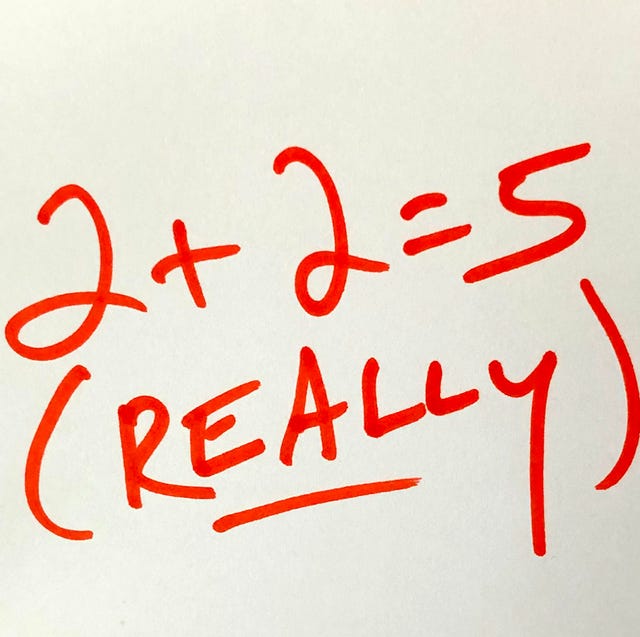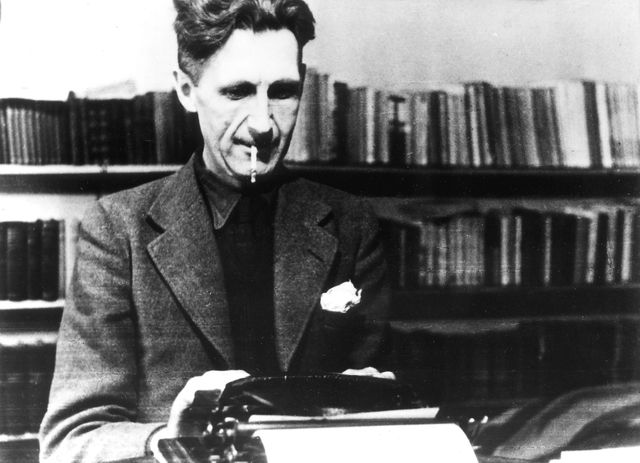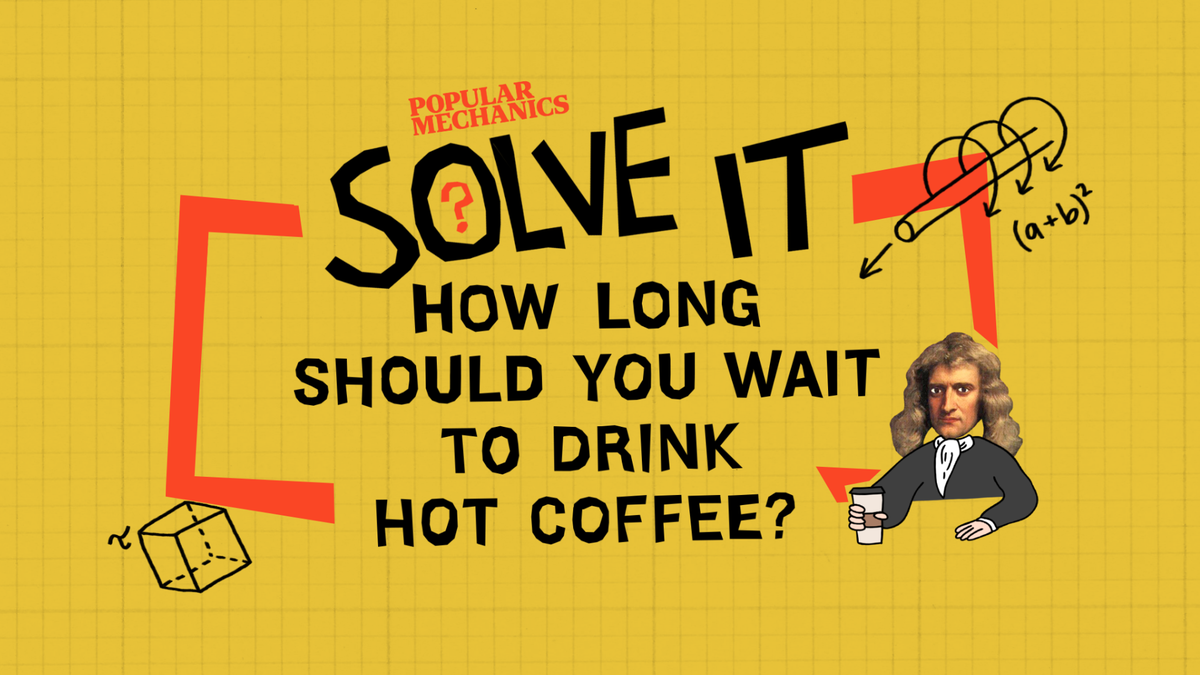On paper, it’s one of the simplest math problems in the world: 2+2. If you’re counting something, like screws at the hardware store, it’s pretty straightforward. But the lines blur in other contexts. If you add 2 cups of vinegar to 2 cups of baking soda, and the reaction produces 5 cups of a fizzy mess, does that mean 2+2=5?
We bring assumptions into the world of mathematics. In this case, the simple “counting numbers”—the whole integers 1, 2, 3, and so on—signify a gulf between math’s abstraction and application. Using “2+2=4” as food for thought, mathematicians are exploring the circumstances in which 2+2 doesn’t actually equal 4, at least not neatly, and we can extend those interpretations to larger questions in epistemology—how we know what we know.
Kareem Carr, a biostatistics Ph.D. student at Harvard University, ignited a “Does 2+2 ever equal 5?” debate on Twitter. On July 30, 2020, he wrote, “I don’t know who needs to hear this, but if someone says 2+2=5, the correct response is, ‘What are your definitions and axioms?’ not a rant about the decline of Western civilization.”
In his Twitter thread, Carr pointed out that counting numbers “are abstractions of real underlying things in the universe,” so we should be mindful of how those abstractions distort truth when introduced to real-world scenarios. Arithmetic works well in a textbook, but practically, it often runs into contextual questions that don’t account for parts of a whole, approximations, or more relevant vectors.
For example, if you’re adding whole degrees to an angle, eventually you’ll circle around to an angle that measures 360 degrees. But a 360-degree angle has the same orientation as a 0-degree angle, so whether the angle measures 0 degrees or 360 degrees depends on context. Likewise, if you drilled a screw five full rotations (1,800 degrees) instead of four (1,440 degrees), the screw’s orientation remains the same, but in one case, it’s deeper inside the lumber.
Carr’s tweet received some replies displaying other examples of arithmetic’s real-world limitations. Many people pointed out that two animals can become three through reproduction (1+1=3, or 1+1=1, depending on your parameters), or that two machines could become three machines if you had some spare parts from each machine and a little elbow grease. Others pointed out that 2.3 rounds down to 2, but 2.3+2.3 rounds up to 5, making it possible through a certain filter that 2+2=5.
In general, the idea that we innately learn counting numbers—whole values only, no fractions or decimals—is a common misconception among people who aren’t trained in math or human development. Young children learn numbers one at a time, by counting, but only begin to learn more sophisticated counting—higher numbers—once they can recognize quantities quickly, an ability called subitizing. It becomes easier for us to count to 7, for example, when we can recognize a group of four things and then count the fifth, sixth, and seventh things. Counting is an unnatural, learned skill—even the nonhuman animals who can “count” to four or five, like dogs and chimps, are considered exceptional—so imposing abstract counting numbers onto the real world creates an innate tension.
There are more problems with the abstraction of on-paper mathematics. Carr grounds his “2+2=5” concept in the ways statistical models can cause harm to marginalized groups across certain parameters. “Whenever you create a numerical construct like IQ, or an aggression score, or a sentiment score, it’s important to remember that properties of this score might not mirror the real things being measured,” he says.
➡️ How 2+2=5 Became Political Propaganda
While Carr’s debate surrounding “2+2=5” is somewhat postmodern in nature, the equation has a storied past as a tenet of anti-intellectualism. For instance, Fyodor Dostoyevsky set up the unnamed protagonist in his 1864 novel Notes from Underground to believe that 2+2=5. Dostoyevsky mused that such an objection of external logic represents the free will that makes a person human.
Meanwhile George Orwell, in a 1943 essay, described Nazi propaganda as a denial of science, noting that if Hitler proclaimed “two and two are five,” it would be received as the only certain truth. Orwell repeated this idea in his novel 1984.
—Courtney Linder
Sentiment scoring is the primary way companies analyze reviews and customer service replies for positive or negative “feeling,” while aggression scales are used in assessing psychiatric patients. In each model, people must assign arbitrary number values (on a scale of 1 to 10, for example) to a criterion that isn’t tangibly measurable—how “pleasant” a transaction was or how “violently” a patient behaved. “When you’re trying to create a statistical construct of some mental phenomenon, my sentiment could be changing from moment to moment,” Carr explains. “You’re not really sure how concrete this thing is.” It’s hard to rate your feelings when they change so much, or when the minimum or maximum of the scale—is your pain level really a 10, as bad as it could possibly be?—isn’t easily conceived by our experience.
Some bad-faith critics flooded Carr’s mentions, saying the value of math is its reliability and rigidity. But Carr’s response points to the distinction between using math as a tool to find answers and math as a tool to learn. “There are a lot of people who seek out math and statistics for a sense of certainty: ‘This is the answer,’” he says. “And there are people who close their minds. I’m more on the other side: Is there something else I could discover in this complex of ideas? It’s a thrill of discovery, like when people do metal-detecting.”
Ultimately, Carr says expanding people’s conception of the pros and cons of various mathematical applications will lead to deeper critical thinking about the way math intersects with our lives. “There’s a need for this sort of thinking, because we’re basically turning everything into data,” he says. Movies have Tomato-meters, podcasts have star ratings, and social media is rife with ratios. “If we’re going to be a world that’s just in apps, we need to be sure these things are working how we think they work.”
🎥 Now Watch This:

Caroline Delbert is a writer, avid reader, and contributing editor at Pop Mech. She's also an enthusiast of just about everything. Her favorite topics include nuclear energy, cosmology, math of everyday things, and the philosophy of it all.














